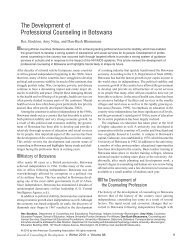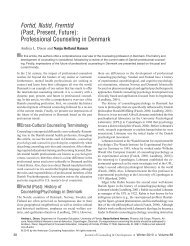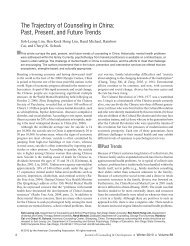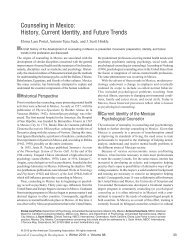Professional Counseling in Romania: An Introduction - IRCEP
Professional Counseling in Romania: An Introduction - IRCEP
Professional Counseling in Romania: An Introduction - IRCEP
You also want an ePaper? Increase the reach of your titles
YUMPU automatically turns print PDFs into web optimized ePapers that Google loves.
Szilagyi & Paredes<br />
Post-Communist Era (1989–Present)<br />
With the fall of Communism <strong>in</strong> 1989, the average <strong>Romania</strong>n<br />
citizen experienced immediate changes. Instantly, skills such<br />
as entrepreneurship, <strong>in</strong>dependent th<strong>in</strong>k<strong>in</strong>g, and consumer decision<br />
mak<strong>in</strong>g became critical. The adm<strong>in</strong>istrators of educational<br />
and career/vocational support <strong>in</strong>stitutions were tasked with<br />
restructur<strong>in</strong>g what services were provided, their <strong>in</strong>stitutional<br />
scope and roles, and how services were provided.<br />
Education. Follow<strong>in</strong>g the revolution (i.e., the fall of Communism),<br />
the <strong>Romania</strong>n education system was reorganized<br />
to more closely align with the systems of western Europe.<br />
The national curriculum and the grade promotion system<br />
were redrafted to better develop the skills necessary for<br />
competition <strong>in</strong> the free market as well (Bethell & Mihail,<br />
2005; Szilagyi, 2005; Velea & Botnariuc, 2002). Included <strong>in</strong><br />
the education reforms were various policies that highlighted<br />
the need for a counsel<strong>in</strong>g mechanism to replace the state’s<br />
student assignment mechanism. M<strong>in</strong>istry of Education<br />
(MoE) orders and other central government policies provided<br />
a base for the development of Psycho-Pedagogical Assistance<br />
Centers (PPACs) and Inter-School Psycho-Pedagogical Assistance<br />
Centers (ISPPACs) <strong>in</strong> 1995. These centers provided<br />
services consistent with what counselors <strong>in</strong> the United States<br />
recognize as school counsel<strong>in</strong>g. Additionally, the Institute<br />
of Educational Sciences, a government research and policy<br />
development th<strong>in</strong>k tank, was granted the authority to develop<br />
school counsel<strong>in</strong>g recommendations.<br />
Career/vocational. Reform <strong>in</strong> the career/vocational support<br />
sector after the revolution was grounded <strong>in</strong> the needs result<strong>in</strong>g<br />
from the widespread development of the private sector. Bus<strong>in</strong>esses<br />
demanded employees with knowledge and skills <strong>in</strong> a<br />
way that was new to most <strong>Romania</strong>ns. For the average worker,<br />
employment was no longer guaranteed, especially if they were<br />
not qualified, and competition for jobs was now commonplace.<br />
Unfortunately, the skills to understand the job market or to<br />
promote one’s skills to potential employers had not been developed<br />
dur<strong>in</strong>g the Communist era. As a consequence of the<br />
adoption of market-driven employment practices, assignment<br />
offices were reorganized <strong>in</strong>to employment assistance offices.<br />
Perhaps more important, the empowerment of <strong>in</strong>dividuals to<br />
make employment decisions was emphasized. As 20th-century<br />
events created a need for counsel<strong>in</strong>g services, formal structures<br />
for the provision of these services were <strong>in</strong>troduced.<br />
Historical Development of <strong>Counsel<strong>in</strong>g</strong><br />
<strong>in</strong> <strong>Romania</strong><br />
As <strong>in</strong> many other countries, professional counsel<strong>in</strong>g <strong>in</strong> <strong>Romania</strong><br />
has been mov<strong>in</strong>g from paraprofessional to professional<br />
status and has developed <strong>in</strong> response to the country’s social,<br />
educational, and economic needs (Bond et al., 2001; Harper<br />
& Deen, 2003; Schweiger et al., 2005). Although the bulk of<br />
the development of counsel<strong>in</strong>g as a discipl<strong>in</strong>e has taken place<br />
<strong>in</strong> the post-Communist era, we believe it is also important to<br />
acknowledge earlier events that facilitated the current development<br />
of professional counsel<strong>in</strong>g.<br />
Pre-Communist Era (1924–1947)<br />
Dur<strong>in</strong>g the period of <strong>in</strong>dustrialization between World Wars I<br />
and II, research psychologists began <strong>in</strong>vestigat<strong>in</strong>g personality<br />
and vocational profiles through standardized test<strong>in</strong>g (Peteanu,<br />
1997). The M<strong>in</strong>istry of Labor (MOL) created three psychotechnical<br />
<strong>in</strong>stitutes to house these researchers and promote<br />
guidance research activities. The staff at the <strong>in</strong>stitutes was<br />
charged with develop<strong>in</strong>g the tools necessary for vocational<br />
and educational guidance, placement, and personnel promotion<br />
(Peteanu, 1997).<br />
The tools and techniques developed by the psychotechnical<br />
centers were further ref<strong>in</strong>ed by practitioners serv<strong>in</strong>g the<br />
public at 15 Vocational Guidance Offices. The staffs at these<br />
offices were responsible for promot<strong>in</strong>g new psychological<br />
and vocational outlooks <strong>in</strong> families and secondary education<br />
sett<strong>in</strong>gs; develop<strong>in</strong>g job profiles for publication <strong>in</strong> the Occupations<br />
Monograph; and assist<strong>in</strong>g <strong>in</strong> <strong>in</strong>telligence, personality,<br />
and vocational test development.<br />
Communist Era (1947–1989)<br />
The services at this time might be more accurately characterized<br />
as assignment because client choice was <strong>in</strong>frequently taken <strong>in</strong>to<br />
account. Services cont<strong>in</strong>ued to be provided <strong>in</strong> the MOL’s Vocational<br />
Guidance Offices (Peteanu, 1997). Access to services<br />
was also improved by the MoE’s development of School and<br />
Vocational Guidance Offices. Typically, service providers had<br />
limited tra<strong>in</strong><strong>in</strong>g <strong>in</strong> help<strong>in</strong>g skills, career development, or other<br />
counsel<strong>in</strong>g-related competencies.<br />
Post-Communist Era (1989–Present)<br />
The current period of counsel<strong>in</strong>g service development began<br />
with a series of educational reforms that took place <strong>in</strong> the early<br />
1990s (Szilagyi & Paredes, 2004; Velea & Botnariuc, 2002).<br />
A time l<strong>in</strong>e of significant events is provided <strong>in</strong> Table 1. Most<br />
<strong>in</strong>strumental was the Education Law 84/1995, which mandated<br />
the creation of PPACs and ISPPACs to provide counsel<strong>in</strong>g<br />
services to children, parents, and educational staff (Peteanu,<br />
1997; Szilagyi, 2005). School counselors were required to<br />
hold a bachelor’s-level license <strong>in</strong> education, psychology, social<br />
work, or sociology. Although counsel<strong>in</strong>g-specific tra<strong>in</strong><strong>in</strong>g<br />
was available, as cont<strong>in</strong>u<strong>in</strong>g education or as master’s-degree<br />
course work from select university faculties, this tra<strong>in</strong><strong>in</strong>g was<br />
not required for school employment.<br />
<strong>An</strong>other key development <strong>in</strong> the post-Communist era was<br />
the <strong>in</strong>clusion of a counsel<strong>in</strong>g unit <strong>in</strong> the 1998–1999 national<br />
school curriculum. This unit, the National Curriculum for<br />
<strong>Counsel<strong>in</strong>g</strong> and Guidance, mandated the allotment of 1 hour of<br />
counsel<strong>in</strong>g per week, start<strong>in</strong>g <strong>in</strong> the fifth grade and cont<strong>in</strong>u<strong>in</strong>g<br />
until secondary school completion. By 2006, more than 80,000<br />
24<br />
Journal of <strong>Counsel<strong>in</strong>g</strong> & Development ■ W<strong>in</strong>ter 2010 ■ Volume 88







